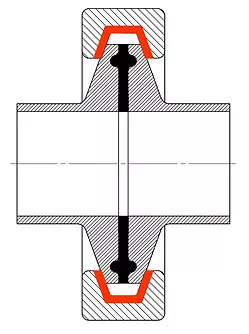The Elasto Clamp

The Elasto Clamp
In our opinion, the Elasto-Clamp® is a revolutionary discovery as it does something we never thought could be done. The elastomeric gasket in all its varieties is still the preferred gasket in our industry because it is flexible and it always seals. We all know that elastomeric seals create problems inside the pipeline. The gasket is pushed inside the flow path because of over-compression and expansion. This problem is even worse after steaming in place (SIP), not to mention after repetitive steam cycles. After each steam cycle, the gasket is pushed in further and further. If the rubber is exposed inside the flow path it becomes vulnerable. Water (media) passing the gasket at a high velocity can be very abrasive, causing parts of rubber to break out eventually.
The Elasto-Clamp® is patented.
How do they do it
Let´s go back to the accumulation of rubber pushing inside the flow path, and why this is happening. When parts are heated, they will expand. Stainless steel piping is expanding at a certain rate but the elastomer is expanding at a much greater rate. Here is a conflict that causes the elastomer to move up into the flow path. The rubber cannot go anywhere else but inside the pipeline, and of course to the outside of the ferrule. The fact itself that the rubber moves inside the pipe are not a problem because we expect the rubber to retract again after the cool down cycle.
This is the point where things are drastically going wrong.
Start the video below and read on the side what you are looking at. Only with a desktop computer.
Start the video below and read on the side what you are looking at. Only with a desktop computer.
The Solution
The Elasto-Clamp® has an elastomeric bonded liner at the V-grove surfaces. This elastomeric section allows for expansion and retraction movement, and for maintaining sufficient force to keep the gasket closed (10 Bar @ 1.5Nm). With this clamp mounted in the above setting, we learned that the gasket does retract to its original position, time after time. The animation at the top of this page shows what happens in real life.
The simple explanation is that the two elastomers, the gasket and the elastomeric liner inside the clamp, have identical expansion rates and keep this movement well balanced. It allows the ferrules to move sideways without losing the integrity of a sterile system.
The Elasto-Clamp® is available in two sizes, 1/2″ and 1-1/2″ (25 and 50,5 mm flanges). We learned that the effects of larger clamps diminish. The effects are minimal.
The Elasto-Clamp® can be equipped with an Anti-Vibration Wing Nut.
Note: The Elasto-Clamp® cannot be used in combination with PTFE type gaskets, only elastomeric gaskets are recommended.

